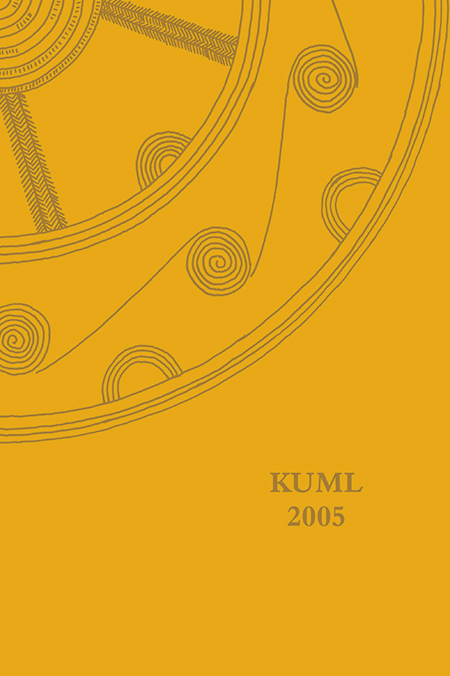Tilgængelighedsanalyse – en arkæologisk metode?
DOI:
https://doi.org/10.7146/kuml.v54i54.97317Nøgleord:
TilgængelighedsanalyseResumé
Access analysis – an archaeological method?
Access analysis is a methodological instrument for analysing spatial structures developed by B. Hillier and J. Hanson (Hillier & Hanson 1984). This form of analysis was defined in the middle of the 1980s with reference to working up architectural plans. As the method does not only operate with the physical relations, but also regards these as a constitution of social circumstances and ideas, the method has also been employed by archaeologists. If one is able to understand social structures by reading and analysing spatial structures, one is working oneself into a central field of archaeology.
The method takes a building’s spatial structure as its starting point. In order to carry out an analysis like this it is necessary to know the complete structure of a building. According to a developed scheme with symbols representing the different building elements, the spatial structure is translated into gamma-maps. According to the hierarchic position of the depth of a single element in proportion to the whole building, these maps are translated into justified gamma-maps. Access to the whole building as well as to the individual rooms in reciprocal relation is a prerequisite for the analysis. That is, justified gamma-maps graphically represent a building’s spatial structures and can be interpreted from the structures’ reciprocal relations (Figs. 1-5).
However, as the method was not defined and developed with reference to an archaeological context, there are problematic elements in translating the method from its original context into archaeology. Various elements will be ignored when using access analysis as a methodological instrument in archaeology.
There are problematic elements in reducing the spatial structure of a building to symbols with simplified connotative characters in connection with the transcription into gamma-maps. First of all, the relative sizes and shapes of the rooms will be ignored. They cannot simply be characterized as standardized sizes (Fig. 6).
Further, not only physical elements are overlooked in gamma-maps and justified gamma-maps. Several elements will not appear through spatial structures and will thus not be taken into consideration in Hillier & Hanson’s analytic model. Examples are possible room decorations, symbolism in location and room distribution of a building, tradition and building material. Several of these elements would not be recognized in an archaeological excavation, but are likely to have been of importance in contemporary culture. The problem with these elements is that even if they were recognized in the archaeological material, their significance practically could not be established without non-archaeological information. It is in fact a previous knowledge or concept of a society that contributes to interpretation of a building’s social structures in Hillier & Hanson’s analytic model.
As access analysis focuses on physical relations, a vital aspect is lacking that makes buildings what they are for both society and individuals: the human use and understanding of a building. Also, the aspect of time is overlooked in gamma-maps. The context in which a building is to be read and understood is changing throughout time. This is clearly a weakness in this way of analysing. Access analysis can be characterized as static, as opposed to the social reality in which a building operates. And this very conflict influences the result of the analysis in a negative way.
An example of the practical use of access analysis is Neil Price’s article, ”House and Home in Viking Age Iceland. Cultural Expression in Scandinavian Colonial Architecture.” With a starting point in access analysis, he analyses Viking houses in Iceland. His aim is to find a Scandinavian idea of the concept of home. He does point out how spatial structures of the houses change through time, and how active factors must be a result of the inhabitants and their social structure. However, this is no more than one can tell just by the spatial structures of the houses and the theory of the method. Conclusions based only on the access analysis method as in this case seem to be no more than an argumentative circle. As shown by this example, it is important to recognize the limitations of the method when using it for archaeology. As mentioned above, several other factors must be taken into consideration.
Theoretically, the method implies that one agrees with Hillier & Hanson that there is a relatively direct relationship between physical and social structures. Even at this point there are objections as to the use of access analysis and its basic theory within archaeology.
Even though the gamma-maps represent building structures graphically in a way that permits a relatively easy comparison between houses, the method has its limitations. And the conclusion must be that Hillier & Hanson do not provide a general theory for analysing spatial structures and the social structures behind these.
Kirsten Pugdahl Pedersen
Aarhus Universitet
Translated by Annette Lerche Trolle
Downloads
Publiceret
Citation/Eksport
Nummer
Sektion
Licens
Fra og med årgang 2022 er artikler udgivet i Kuml med en licens fra Creative Commons (CC BY-NC-SA 4.0).
Alle tidligere årgange af tidsskriftet er ikke udgivet med en licens fra Creative Commons.


